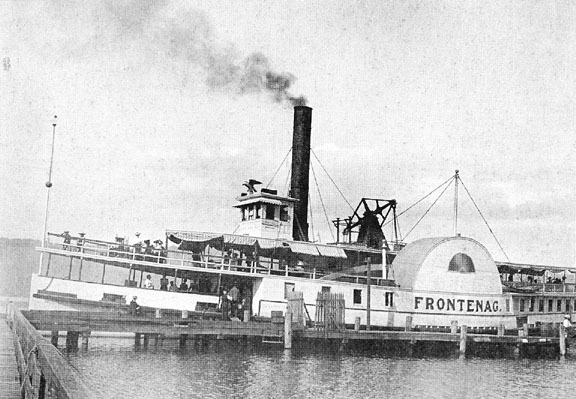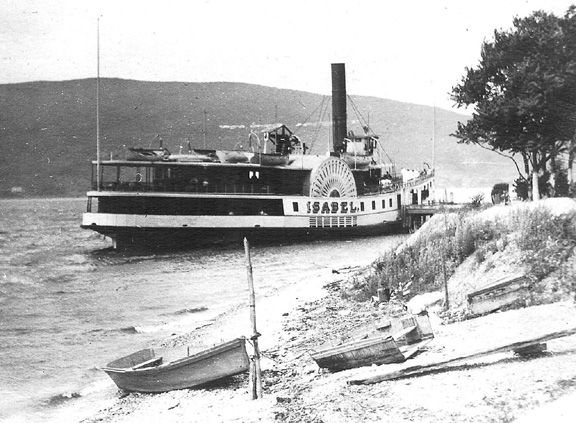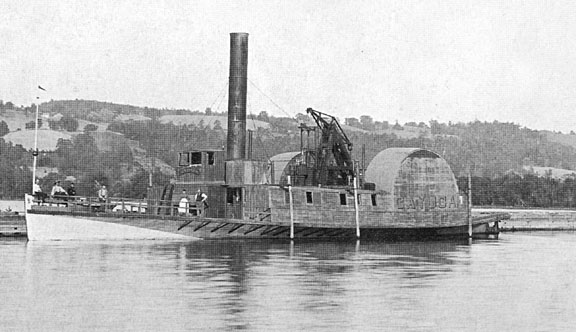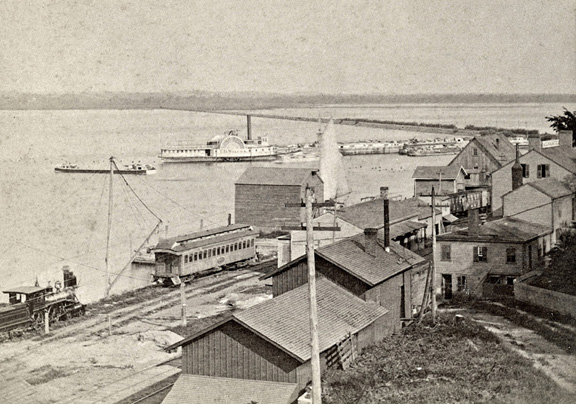|
Oldtimers Recall Palmy Days of
Steamboating on Cayuga Lake
by
Throughout the 19th century and into the early 20th century, Cayuga
Lake was one of the major feeders to the Erie Canal. Steamboats towed wooden
barges between the village of Cayuga and Ithaca. The following accounts were
written in local newspapers at the turn of the last century. The first account
was written as a letter to a local newspaper by George S. Humphrey of New York
City and
is
dated
June
1,
1912,
the year
when
all commercial
steamboating
ceased
on the lake. The letter appeared in the Auburn Citizen on June 7,
1912. The second account is from an article in the Auburn Weekly Bulletin,
on Aug. 20, 1907. The final item included is a tribute to the steamboat Simeon
DeWitt that
appeared in the Ithaca Chronicle, on July 8, 1840, at the beginning
of its career.
Auburn Citizen, June 7, 1912
Letter from George S. Humphrey, New York
City, June 1, 1912
The information recently contained in the Journal to the effect that steam navigation on Cayuga Lake, as a business has ceased to exist comes with something of a shock by those, who, like myself, recall the days when the line of steamers plying between Ithaca and Cayuga, formed a very important factor in the means of transportation connecting the southern portion of the State with the central regions, as well as the East and West.

“ Frontenac” at the steamboat dock at Union Springs on a long-ago summer
day.
Photo courtesy of Bill Hecht, Union Springs.
I feel quite sure that there are a number of people now living in Ithaca,
who can speak from a greater and more accurate knowledge on this subject than
myself; but it occurs to me that some reference to it may be of interest to
your readers and also tend to draw from others further information in regard
to a matter which was at one time of so great importance to Ithaca, and indeed
the entire state.
My own information dates from a poster in my possession, dated May 19, 1867, signed by my father, the late William R. Humphrey, as superintendent, announcing the opening of a line of travel from Owego via the ‘Cayuga & Susquehanna R.R. connecting the New York & Erie Railroad with the Albany and Buffalo Railroad, via Ithaca and Cayuga Lake,’ the journey between Owego and Buffalo being made in the remarkable short time of ‘about 12 hours’; but it is well known that steamboats were operated on the lake long before this date.
While I recall reference to the Telemachus, Simeon DeWitt, and William
E. Dodge, my own recollection goes back to the 60’s when the Kate
Morgan made daily trips through the lake, leaving Ithaca about 7 a.m., reaching Cayuga Bridge about noon, and arriving back at Ithaca about 7 in the evening. The Aurora left Ithaca in the middle of the afternoon, laid up all night at Cayuga, returning to Ithaca in the morning. These boats carried passengers and freight and made several landings on both sides of the lake.

Steamer Iroquois at Kidder’s Landing on the west side of Cayuga Lake.
Photo courtesy of Bill Hecht, Union Springs.
With the exception of the Auburn stage, at that time, the boats afforded the only means of transportation north of Ithaca, and handled all the business for the lake communities except during the winter months; they also carried the United States mails, thus making it profitable to operate the line much earlier in the spring and later in the autumn than was the case after the railroads were constructed on or near both shores of the lake.
Besides the two passenger boats was the tow boat Sheldrake —a
very important factor in the enterprise for in those days large quantities
of grain were produced on the farms lying east and west of the lake and brought
to the warehouses situated at convenient points, and thence loaded into canal
boats which were in turn towed to Cayuga, where they entered the Erie Canal;
or to Ithaca where the grain was handled in the elevators operated by the Halseys,
and William W. Esty, and ground in the local mills or re-shipped by rail to
Owego and points beyond. But probably the most important tonnage consisted
of anthracite coal for at that time the D.L. & W. R.R. had no lines of its
own beyond Great Bend. Practically all its product destined for points north
of Scranton was carried by a trackage arrangement over the Erie road to Owego,
thence by Cayuga & Susquehanna (which then, as now, was operated under a lease)
to Ithaca, where by means of trestles and chutes at the Inlet the coal was
loaded on canal boats which the Sheldrake towed to Cayuga.

Steamer and yacht at Renwick Beach in Ithaca, site of today’s Stewart Park.
Photo courtesy of Bill Hecht, Union Springs.
All these boats were, of course, constructed at Ithaca, or some point on the lake shore. The engine of the Aurora was built by Treman & Cartwright of Ithaca but the others either at Albany or New York; I remember the names of Cobanks & Theal, and the Novelty Iron Works among the makers. The Sheldrake’s engine was very old, having been originally installed in a New York ferry boat. It had a valve motion of a peculiar design operating with a sort of snap or click watch that could be heard for miles over the water. I believe this was altered before the boat was finally broken up, but I wish it might have been preserved in the University Museum.
The boats were owned and operated by Capt. T.D. Wilcox, a picturesque character, nervous, quick in speech and action, sometimes hasty in temper, but withal of a sweet and kindly disposition and who must today be remembered by many an Ithacan with sincere affection. The men who composed the official staff and managed the boats were all of ability and high character. Captain Goodrich, who commanded the Kate
Morgan, of a trim figure and careful of his personal appearance, impressed me as a boy with a refinement and nicety of bearing which would have fitted him to command the private yacht of a Morgan or Gould.
Capt. Chet Dryer of the Aurora seems, as I look back at him through the memory
of years, to have been an ideal sailor, of a ruddy countenance, bluff in manner,
sharp in his orders, and good to boys.
Capt. Martin Ryerson, who handled the Sheldrake seems to me to have been older, and perhaps more sedate; but he enjoyed fun and was a good fisherman, as I can testify from having spent more than one delightful day with him off Springport. And what fishing there was there in those days.
The mail clerk on the Kate Morgan was George Blood, a brother of the late Col. Charles H. Blood, and whose life must be a pleasant memory to many persons still living in Ithaca.
And who among the host who traveled on the old boats can forget Billy Hatch and his famous chicken ‘suppahs,’ the enjoyment of which was well worth a trip ‘through the lake.’
As most of your readers will remember, the Cayuga Lake boats formerly landed
at the ‘Steamboat Landing’ on the Inlet, near the mouth of Cascadilla Creek,
where there are now numerous boat houses. When the steamer arrived in the evening
there was great excitement. The sands in the Inlet at that point made the landing
difficult and Capt. Wilcox was always on hand to shout directions to the officers
in charge of the boat and to express his disapproval of an awkward move in
no uncertain terms.
There were ‘busses’ from the Clinton and Tompkins House, Ithaca Hotel and
Watkins Exchange; the runners for these hostelries announced themselves in
loud and vociferous voices. There were also ‘hacks’ of various kinds, the most
popular drivers as I remember them, being Ad Norton and Josh Woodruff. Not
far off stood the night train for Owego, great volumes of wood smoke pouring
from the big bell-shaped stack of the locomotive (usually the ‘Lackawanna.’)

Steamer Isabel at one of her summer-time stops in the early 1900s.
Photo courtesy of Bill Hecht, Union Springs.
Although the scene was one of great importance, and I think there is nothing in Ithaca now to compare with it, unless it be the return of a successful Cornell crew. It is difficult to realize that the old warehouse has disappeared, its site overgrown with grass and the boats themselves a mere memory.
Sometime after 1865 Captain Wilcox built a small steamboat named Ino, which
it was said at the time, was constructed in order to utilize the engine taken
from the long defunct Simeon
DeWitt. She was designed as an excursion boat, but was cranky and did
not remain long in service. Somewhere about 1870 the Aurora was
superseded by the Frontenac and soon after the T.D.
Wilcox took the place of the Kate
Morgan. The Wilcox was the largest and most powerful boat ever
floated on Cayuga’s waters, but the Frontenac was of better lines,
perhaps only surpassed by the Morgan which was a beautiful example
of naval architecture. These boats were in existence until very recent times,
and there are many persons in Ithaca who are more familiar with their later
history under the captaincy of the genial James B. Taylor, Captain VanOrder
and others, than I am.
In the early days, I think there was only one other steam craft on the lake—a
propeller named Nellie
Cartwright, designed and built by the late Robert Cartwright, who was
for a time associated with the Tremans in Ithaca and who later removed to
Rochester. He was an engineer of originality and national reputation. My
recollection is that the engine in the boat was of an experimental design
and was eventually
broken up and scrapped—another historical pity.
There were also ferry-boats operating between King’s and Kidder’s Ferry, and between Springport and Varick or Canoga. These boats were sloop rigged and needed sails when there was sufficient wind to propel them. They were, however, equipped with an auxiliary paddle wheel (on one side only) operated by horsepower transmitted by means of a tread mill; this method of propulsion was later superseded by a donkey steam engine, and for all I know to the contrary, these boats or their successors are being operated today.
As intimated before the prosperity of the steamboat business on Cayuga Lake
began to wane with the construction of north and south lines of railroad, not
only along the lake but at other points, such as the Syracuse & Binghamton,
and the Southern Central (now Lehigh Valley, Auburn Branch). With the acquisition
of the S. & B. by the D.L.& W., and later its construction of its own line
to Buffalo, coal shipments via Ithaca dwindled and finally ceased. The opening
up of the great western wheat fields practically killed the grain business
of the ‘lake country,’ and commerce of the lake almost disappeared. When the
Ithaca and Athens Railroad was completed a short revival of the coal business
occurred; but when the Ithaca & Geneva road was built and the two combined
as the G.I. & S., and the line taken over by the Lehigh Valley, coal carrying
on the lake disappeared forever.

One of the old steamers that towed Erie Canal barges was the Cayuga in 1880.
Photo courtesy of Bill Hecht, Union Springs.
In this connection it should be stated that many years ago great quantities of lumber were brought into Ithaca, and shipped by boat to Albany; the business having carried on water by T.S. and L.B. Williams and Henry W. Sage. This, however, was prior to the times to which I have referred.
After the west shore of the lake was developed as a location for summer cottages, small boats like the Horton and Kellogg appeared and served a useful purpose, but they were of a different type from the old side-wheelers, and their history does not properly come with the scope of this article, interesting though it may be.
And so, with the recent burning of the Iroquois and Mohawk,
steam navigation of the lake has ceased; the old warehouses have disappeared,
and the wharves are washed away, or perhaps marked by a few gaunt piles, sticking
out of the water like neglected grave stones. I have just read an old Encyclopedia—Americana,
published in 1831— that Ithaca at that time was a flourishing village
of 4,500 inhabitants enjoying an active trade through Cayuga Lake. It is now,
1912,
a city of some three times that population; what would have its fate have been
had not Ezra Cornell founded the great institution which crowns the hill on
which
only a farm and woods existed when I was a boy, sailing down the lake with
Captain Goodrich?

An 1870’s view taken at the village of Cayuga, showing the steamer T.D.
Wilcox and
the Cayuga Lake Railroad in foreground.
Photo courtesy of Bill Hecht, Union
Springs.
Auburn Weekly Bulletin, Aug. 20, 1907
Traffic on Cayuga. Some Information About Old Time Boats. Before the Railroad
Came.
Business Was Big in Those Days. Something About Ill-Fated Frontenac.
Yesterday's Ithaca Journal printed a cut of a steamboat of ancient type and in connection therewith published the following interesting story:
The . . . Simeon DeWitt, [was] one of the first passenger steamboats on Cayuga Lake. The steamer was commanded by Captain Edward Buckbee and was scheduled to leave Ithaca at 6 a.m. daily for Cayuga, arriving there at 1 p.m. Return trip to Ithaca was then made immediately.
Captain Abraham Schryver of this city, who is 84 years of age, is the oldest
living steamboat man in Ithaca. He now resides a 1002 North Cayuga St. When
seen yesterday afternoon, Captain Schryver was asked to recall some old aquatic
reminiscences. He was shown the picture of the Simeon
DeWitt and said that he well remembered the first trip the steamer made
through the lake. He said that he rode on the boat several times that first
season.
"The manner in which the passengers disembarked from the boat was different
from now, Captain Schryver said. "The docks along the lake were very flimsy
and Captain Buckbee would stop the boat several hundred feet from the shore
where a yawl would be lowered and several trips made to shore pulling the yawl
by means of a rope."
Captain Schryver himself owned a number of boats on the lake but they were
all used for carrying freight. The first boat he built was the Neptune,
a sloop. Then he built the Spy. Later came the Frank, the W.L.
King, the C.S. Ogden and the J.S. Sandford, all canal
boats; the Black
Warrior, a schooner, the Levi Kenny, a canal boat, and the Elfin,
a schooner. The spars were taken off the latter boat several years later
and after it was lengthened, a boiler and engine were placed in the craft
and
it was named Nellie
Bly.
The Levi Kenny, under Captain Schryver, carried the largest load
of coal ever carried on Cayuga Lake by any freighter. Captain Schryver and
Captain Peter Carr of Union Springs were loading coal at the D., L. & W. yards
in this city to run through the lake and Carr wagered that his boat could carry
the biggest load. William R. Humphrey, who then had charge of the yards, placed
282 tons upon the Robert J. Wiley, captained by Carr, but the Levi Kenney stood
at 290 tons.
In speaking of canal boating Captain Schryver said that Captain Edward Tilton of this city, who died a year or two ago, was one of the best known captains on the lake. With the DeWitt
Clinton as tow boat he would take 20 canalers through the lake at one time all in a single line letting them drift along while he ran into various ports and secured additional boats waiting to be taken through the lake.
"Four hundred and fifty to 500 a day above all expenses from passenger traffic alone used to be the regular record of steamers on Cayuga Lake," said Captain Sylvester Norton today. "There were hundreds of passengers for all points east and west passing over Cayuga Lake every day. The most prosperous period extended over 30 years from 1865 to 1895. Then there were the most boats on the lake. Of these the Wilcox was the largest exceeding the others by 15 feet in length and having a greater beam.
"The Sheldrake, Aurora, Frontenac and Kate Morgan were all of a size. Freight traffic was no inconsiderable factor and strings of from five to 12 canal boats were not an uncommon load for a steamer to tow. The heavy traffic was from Ithaca to Cayuga with grain and coal and most of the returning barges were light."
Captain Norton was engaged in the steamboat business from 1855 to 1902. he
was deckhand on the Forest
City in 1855 and became deckhand on the Kate Morgan the following year.
Later he was appointed mate on the Sheldrake, a tow boat, and in 1868 commanded
his first steamer, the Aurora, a tow boat. The first passenger boat of which
he was captain was the Ino, a day boat from Cayuga to Ithaca which lay at
Cayuga nights. The tow boats were operated mostly at night, he said.
Finally Captain Norton was given command of the largest boat on the lake, the T.D.
Wilcox, which was used for passenger and excursion purpose. He had the Frontenac at different times to tow with. His last steamboating was done in 1902 as pilot and master of the Frontenac.
Captain Norton said there were 11 regular landings, Frontenac Beach, Kidder's
Ferry, Sheldrake Point, Aurora, Union Springs, Cayuga Lake Hotel, Ladoga, Taughannock,
Atwaters and Farley's. The location of various hulks was given by Captain Norton
as follows: William
E. Dodds, Jeorgers Cove near Union Springs, used as a dock after having
been dismantled when worn out by age; Forest
City, at Renwick, where sunk after being dissected for old age; R.G.
Howland, burned at Renwick Pier, lies near west shore (Captain Tilton
was aboard it when it burned; Beardsley, built at Union Springs,
dissected after expired usefulness off Renwick; Kate
Morgan, worn out by age and dismantled, lies east of light house; Forest
City, decayed by age and broken up, lies off lime kiln at Renwick; Aurora,
Sheldrake and Ino, all worn out by age, lie near salt works
off Remington Point; T.D.
Wilcox, burned, hull lies off Cayuga.
Albert E. Smith of Hancock Street, who was the pilot of the ill-fated Frontenac from
1874 until it was destroyed last month, has a clear recollection of the early
history of the boats which plied between this city and the foot of the lake.
Mr. Smith, as a little boy, remembers the Puffer, a high pressure
wood burning boat, Simeon
Dewitt, DeWitt Clinton and the Forest City. The boats at that
time offered the only opportunity of travel between the terminal of the D.L.& W.
railroad in this city to the New York Central line at Cayuga. The J.D.
Beardsley was a ferry boat which piled between Union Springs and Canoga.
The machinery on this boat was afterwards put into the Ino which
was launched in 1866.
Mr. Smith first entered the boating business as a deckhand
on the Kate
Morgan under Captain Goodrich, who shot himself in 1870 and on the Aurora under
Captain Dryer. In 1868 he was given a position as deckhand on the Wilcox.
The Frontenac was launched in the fall of 1869, says Mr. Smith,
and it made its first trip through the lake on June 24, 1870. He held the
position of deckhand and the boat was captained by Mike Ryerson. Four years
later Mr. Smith was made pilot of the boat and has held that position during
most of the 33 years from that time until the large craft was burned on
July 27 last, off Farley' s Point.
The second year after the Auburn branch of the Lehigh Valley railroad was built, there was a washout on the line which required some time before it could be repaired. The company purchased the Frontenac and the Wilcox, together with the tow boats, Aurora and Sheldrake and carried on their business for a year by means of the boats.
Mr. Smith was on the Frontenac under a number of managements. The next year after the washout the boats were sold to a company of several men who later sold out to W.H. Hunt. Mr. Hunt died and the boats were owned by Mrs. Hunt for some time. A company of local men then purchased the line and the firm of George & Southworth controlled it for a short period, the boats finally falling into the hands M.P. Brown, who, with his sons, is the present owner of the Cayuga Lake fleet.

One of the grand old steamers on Cayuga Lake was the much-storied Frontenac which caught fire
and burned to the water’s edge on July 27, 1907. Eight lives were
lost in the disaster.
Photo courtesy of Bill Hecht, Union Springs
Ithaca Chronicle, July 8, 1840
Steam Boat Simeon DeWitt
The regularity and noiseless comfort which characterizes the movements of
this beautiful Steamer merit more than passing notice. The transition from
the jarring vehicles of locomotion with which, at either end of her route,
she connects, is really by no means a small one, and were there no other reason,
would be an ample one for consigning ourselves to the charge of Capt. Buckbee
for the three or four pleasant hours, which are all he permits his passengers
to pass in coming from Cayuga Bridge to Ithaca.
The season, (according to the almanac at least though at this present writing
not according to the thermometer,) for fashionable travel is present with us,
and the fair daughters of the South will be leaving the too warm air of the
Carolinas and Georgia for their annual visit to Niagara Falls and the Great
Lakes. A little variation from their accustomed route, we can in good conscience
recommend. To leave the Bridge, and glide in the Simeon DeWitt over
Cayuga Lake, would be of themselves an ample compensation for the one extra
day consumed in the episode to their usual journey; but when to this is added
the visit to this little appreciated, but must beautiful village, or the farther
progress by Rail Road to the Susquehanna, it needs, we know, only one trial
by the traveler, to ensure, at first, wonder that a route so beautiful should
be so little known; and secondarily, the most earnest recommendation to others
to "come and do likewise."
There has been no deviation from the regular and quick passage of the Simeon
DeWitt since her trips have been commenced, except a brief one occasioned
by a break in her machinery. The inhabitants of Cayuga and Seneca, whose pleasure
or business call them to the Lake, find each landing promptly and exactly performed,
and their location and number a great and long called for convenience. Will
our traveling friends make trial and do us (as we are sure they will be compelled
to) the justice to believe that our language of praise has been but that of
sober truth?
|